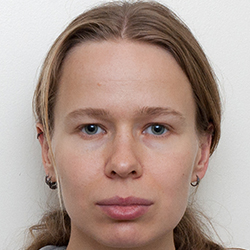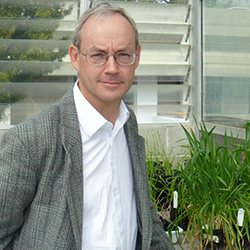Keynote

Epidemiology and Surveillance
08:20 EDT / 12:20 UTC
Moderator: Pablo Olivera, University of Minnesota
- Diversity of Puccinia graminis f. sp. tritici in Ethiopia
- Modelling the Spread of Wheat Stem Rust Fungus (Puccinia graminis f. sp. tritici) through Atmospheric Urediniospore Transport
- Tackling a formidable foe: the re-emergence of wheat stem rust in Western Europe
- RustWatch
- Epidemiology and Surveillance Discussion
Diversity of Puccinia graminis f. sp. tritici in Ethiopia

Speaker:
Endale Abera, University of Minnesota
Abstract
Wheat stem rust, caused by Puccinia graminis f. sp. tritici (Pgt), is one of the most devastating disease of wheat in Ethiopia. In the past decades, many wheat varieties became out of production due to the frequent occurrence of new virulent races. In 2013, SrTmp-virulent race TKTTF caused a severe localized epidemic that resulted in devastating losses to wheat growers in the main wheat growing regions of Bale and Arsi. The current studies were carried out to determine the virulence composition and diversity of Pgt in Ethiopia after the TKTTF epidemic and to gain insight of the role of the alternate host in stem rust epidemiology. Stem rust samples were collected from major wheat-growing areas of the country and race analysis were carried out both at Ambo agricultural research center in Ethiopia and the Cereal Diseases Laboratory (CDL) Minnesota. A total of 24 Pgt races have been identified since the stem rust epidemic in 2013. Races TKTTF, TTKSK, TTTTF, JRCQC, and RRTTF were identified each year in the 2013-2018 period. The most dominant race in the past five years was TKTTF, but the frequency and area coverage of the new race TKKTF has been increasing. Races TKFTP and TTKST with virulence to Sr24 were identified in 2016 and 2017, respectively, and this virulence is significant because several major cultivars rely on Sr24 for stem rust resistance in Ethiopia. Virulence on Ug99-resistance genes such as Sr35, Sr47, Sr1RS Amigo, and Sr13b were also identified in this study. Genotypic analyses of these isolates are being carried out. Race CKGTC with low virulence to most of the wheat cultivars was identified from samples collected from wheat grown adjacent to Berberis holstii. This is likely a result of infection from aeciospores. Continuous occurrence of new virulent races and the presence of barberry plant in Ethiopia underlines the need for monitoring the pathogen population and identifying effective resistance genes that can be used in the national wheat-breeding program to control this devastating disease.
Modelling the Spread of Wheat Stem Rust Fungus (Puccinia graminis f. sp. tritici) through Atmospheric Urediniospore Transport

Speaker:
Marje Prank, Finnish Meteorological Institute / Cornell University
Abstract
Atmospheric transport of urediniospores is an important vector for spreading for many rust fungi. We integrated sporulation, atmospheric spore transport and infection of wheat stem rust (Puccinia graminis f. sp. tritici) into the Community Earth System Model. The model allows us to characterize how climate impacts the risks of crop damage from the disease, as well as the role that land management strategies and agricultural practices (distribution of crops, irrigation, timing of crops, crop susceptibility etc.) could play in modulating the losses.
Evaluating the model is challenging, as available data consist of voluntary reports from farmers to USDA. Not all crops are constantly monitored, so infections can stay unnoticed and not all detected infections are reported. The reports show the wheat stem rust starting in southern USA and gradually spreading northwards during spring and summer. Our model qualitatively reproduces this behavior, while showing a low level of infection in wide areas, which would not be detected and reported. The model can reasonably capture the speed of the northwards spread.
We have applied the model to quantify the impacts of changing climate to various stages in the wheat stem rust life cycle globally. Simulations were made for the modern and future (2100, RCP8.5) climate conditions. Model results indicate reduction in days with viable spore transport between Europe, Africa, Arabian Peninsula and South Asia. The number of transport days increases for eastward connections in the southern hemisphere, with the exception of South-Africa to Australia. We show conflicting impacts from raising temperatures and decreasing relative humidity – although the predicted warmer and drier climate benefits the urediniospore production and escape to free atmosphere, the same factors significantly inhibit the germination of the deposited spores.
Tackling a formidable foe: the re-emergence of wheat stem rust in Western Europe

Speaker:
Diane Saunders, John Innes Centre
Abstract
Wheat stem rust has been associated with crop failures throughout history. Recent increased incidence in western Europe could signify the return of this formidable foe. Accordingly, alterations in climatic conditions over the past 25 years are consistent with increasingly conducive conditions for pathogen growth and infection. We investigated whether a lack of resistance in modern European wheat varieties, increased presence of the alternate host barberry, alongside changes in climatic conditions could be brewing the perfect storm for stem rust resurgence. In 2013, we recorded wheat stem rust in the UK for the first time in over 60 years and showed that over 80% of wheat varieties were susceptible to this strain. Furthermore, the pathogens alternate host (Berberis spp.) has been increasing in popularity and increased plantings are raising concerns this could facilitate the pathogens re-establishment. In 2016, we documented stem rust for the first time in the UK in many decades on its alternate host common barberry. Since, a wider scale search in 2018 and 2019 has identified stem rust in multiple locations across the UK. Furthermore, infection assays showed that aeciospores collected from barberry at many sites are capable of infecting barley, wheat and rye. By integrating spore dispersal models and citizen science to identify barberry locations, we are developing a risk model to better guide re-planting efforts to minimize the risk new plantings could pose to escalating cereal rust diversity in the future.
RustWatch: A European early warning system for wheat rust diseases

Speaker:
Mogens Hovmoller, Aarhus University
Abstract
RustWatch will establish a stakeholder driven early-warning system to improve preparedness and resilience to emerging rust diseases on wheat, which is Europe’s largest agricultural crop. This is urgent because Europe in 2016 experienced the most severe epidemics of wheat stem rust for more than 50 years, and the pre-existing population of wheat yellow rust has been replaced by invasive races of non-European origin.
RustWatch provides beyond state-of-theart research within new diagnostic tools, enabling rapid and precise identification of new invasive races, and investigating the impact of virulence, aggressiveness and adaptation to warmer temperatures as drivers of pathogen spread and establishment. The research has potential for a break-through in the area of host resistance phenotyping, e.g., by going beyond the observation of disease and categorize resistance responses at the cellular level. This phenotyping is essential for utilizing the vast amount of genomic sequence information produced by new emerging breeding technologies.
The early warning system for prevention and control of rust diseases will become implemented via case studies in five regions. The case studies will aid in development and validation of the systems in collaboration with a wide array of stakeholder groups, involve agricultural advisers in disease surveillance and sampling for later diagnosis, and collect information about potential barriers in adopting the system.
RustWatch engages 12 universities/research institutes, 5 agricultural advisory services, and 7 SMEs/industries.
Epidemiology and Surveillance Discussion led by Moderator Pablo Olivera, University of Minnesota

Endale Abera

Marje Prank

Diane Saunders
Molecular Host-Pathogen Interaction
09:00 EDT / 13:00 UTC
Moderator: Diane Saunders, John Innes Centre
- Using Virulence Mutants to Identify Avr Genes in the wheat stem rust fungus, Puccinia graminis f. sp. tritici.
- Under attack by a cereal killer: Chloroplasts as key pathogen targets
- High frequency selection of fungicide resistance-associated mutations in the wheat yellow rust pathogen Puccinia striiformis f. sp. tritici
- Molecular Host-Pathogen Interaction Discussion
Using Virulence Mutants to Identify Avr Genes in the wheat stem rust fungus, Puccinia graminis f. sp. tritici.

Speaker:
Peter Dodds, CSIRO
Abstract
Rust fungi are biotrophic pathogens that depend on living host cells for their growth and form specialised haustoria structures during infection that serve as nutrient uptake sites as well as delivering effector proteins to the host cell. We have been investigating the molecular basis of rust infection and immunity using Melampsora lini (flax rust) as model system and extending this work to Puccinia graminis f. sp. tritici (Pgt) (wheat stem rust) which is one of the most destructive pathogens of wheat. We recently generated a chromosome level genome assembly for Pgt based on Pacbio sequence and HiC scaffolding, which has enabled us to characterise a number of spontaneous virulence mutants. Most result from complex structural rearrangements in the genome, including translocation events between chromosomes and even exchange of chromosomes between the haploid nuclei of this dikaryotic fungus. This has led to identification of several Avr genes from Pgt, as well as development of new tools for testing effector function in wheat including viral overexpression and wheat protoplast transient expression assays. Avr genes in both M. lini and Pgt encode secreted proteins that are co-ordinately expressed during infection and localised to haustoria structures.
Under attack by a cereal killer: Chloroplasts as key pathogen targets

Speaker:
Francesca Minter, John Innes Centre
Abstract
Wheat-infecting rust fungi of the Pucciniaceae family including Puccinia striiformis f. sp. tritici (PST) and Puccinia graminis f. sp tritici (PGT) pose a significant and sustained threat to global wheat production. Previous research has shown that wheat yield losses associated with rust infection result from a reduction in the photosynthetic capacity of the plant. Additionally, it is widely understood that the chloroplasts are a hub for the synthesis of a number of pro-defence molecules including reactive oxygen species, calcium ions and salicylic acid, making them important organelles for coordinating the immune response. However, the molecular details of how chloroplast processes are manipulated during wheat infection with rust fungi remain to be elucidated. The main objective of this project is to investigate the ways in which wheat chloroplasts are targeted by rust fungi to facilitate disease progression. To this aim, RNA-sequencing carried out on PST-infected wheat tissue over an infection time-course has been used to identify a number of nuclear-encoded chloroplast genes (NECGs) with conserved expression patterns that correlate with resistance to PST. To characterise the function of these proteins in wheat during rust infection we have obtained loss-of-function mutants from a tetraploid Targeted Induced Local Lesions In Genomes (TILLING) population. Infection of these mutants with PST and PGT will enable us to determine whether these chloroplast proteins are important for infection progression. Candidate genes which show an alteration in infection severity will be taken forward for further molecular characterisation. This analysis will enable us to gain an understanding of the ways in which the chloroplasts are targeted by rust fungi during infection. This study may also help to identify novel targets for disease resistance.
High frequency selection of fungicide resistance-associated mutations in the wheat yellow rust pathogen Puccinia striiformis f. sp. tritici

Speakers:
Richard Oliver, Curtin University
Abstract
The reliance on fungicides to manage disease creates a selection pressure for the evolution of resistance in fungal and oomycete pathogens. Rust fungi (Pucciniales) are major pathogens of cereals and other crops and have been classified as low-risk organisms to develop resistance to fungicides; no cases of field failure of fungicides in a cereal rust disease has yet been recorded. Recently, the Asian soybean rust pathogen, Phakopsora pachyrhizi evolved resistance to several fungicide classes, prompting us to screen a large sample of the globally widespread wheat yellow rust pathogen, Puccinia striiformis f. sp. tritici (Pst), for mutations associated with fungicide resistance. We evaluated 363 Pst isolates collected from Europe, USA, Ethiopia, Chile, China and New Zealand for mutations in the target genes of demethylase inhibitor (DMI; Cyp51) and succinate dehydrogenase inhibitor (SDHI; SdhB, SdhC and SdhD) fungicides, the major chemical controls for wheat foliar diseases. A high proportion of Pst isolates carrying a Y134F DMI resistance-associated substitution in the Cyp51 gene was found among those from China and New Zealand. A set of geographically diverse Pst isolates were also found to display a substitution in SdhC (I85V) that is analogous to that reported recently in P. pachyrhizi and linked to SDHI resistance. The identification of these resistance-associated alleles confirms that cereal rust species are not immune to fungicide resistance and that selection for resistance evolution is operating at a high level in certain locations. It highlights the need to adopt fungicide resistance management practices and to monitor cereal rust species for development of resistance.
Molecular Host-Pathogen Interaction Session Discussion
Led by Moderator Diane Saunders, John Innes Centre

Peter Dodds

Francesca Minter

Richard Oliver
Alternate Hosts and Pathogen Biology
09:45 EDT / 13:45 UTC
Moderator: Radhika Bartaula, University of Minnesota
- The role of somatic hybridization in the evolution of the Ug99 lineage of the wheat stem rust pathogen
- Rust expression browser: a powerful, flexible and open resource for transcriptomics in wheat yellow rust (Puccinia striiformis f. sp. tritici)
- Elucidating the evolution history of Puccinia graminis f. sp. tritici lineages through analysis of allelic variation of selected genes
- Alternate Hosts and Pathogen Biology Discussion
The role of somatic hybridization in the evolution of the Ug99 lineage of the wheat stem rust pathogen

Speaker:
Melania Figueroa, CSIRO
Abstract
Newly emerged strains of the wheat stem rust pathogen, Puccinia graminis f. sp. tritici (Pgt), such as Ug99, are a threat to global food security. In spite of their economic importance evolutionary origin of these Pgt strains still puzzles the scientific community. Like many basidiomycetes, Pgt is a dikaryotic fungus with two haploid nuclei (karyons) during its wheat infection cycle. To better understand the genomic architecture and evolution of this pathogen we recently developed a new strategy to generate haplotype-phased genome assemblies of Pgt by coupling PacBio long reads and Hi-C data. We discovered that Ug99 shares one complete haploid genotype (haplotype) with a much older African strain, based on fully haplotype-resolved genome assemblies. The absence of recombination or chromosome reassortment in the shared haplotype indicates that Pgt Ug99 arose by a somatic hybridization and nuclear exchange event. Such nuclear exchange between dikaryotes can be an important factor in generating genetic diversity and enabling the emergence of new adapted lineages in asexual fungal populations.
Rust expression browser: a powerful, flexible and open resource for transcriptomics in wheat yellow rust (Puccinia striiformis f. sp. tritici)

Speaker:
Thomas Adams, John Innes Centre
Abstract
Wheat yellow (stripe) rust, caused by the fungal pathogen Puccinia striiformis f. sp. tritici (Pst), is an important threat to global wheat production. Ongoing work in the Saunders lab to integrate genomics-based techniques into wheat rust surveillance has generated over 1,000 RNA-Seq datasets from Pst-infected field-collected leaf samples. As part of the EU Horizon2020 RustWatch program we are creating an open access web application to allow the visualisation and exploration of transcriptomic data on a desktop computer. This will be implemented on the expression visualisation and integration platform (expVIP), developed for the wheat expression browser. This first use case of expVIP for a pathogen species demonstrates the flexibility of this platform for improving the accessibility of transcriptomic data. Users are able to visualise expression patterns for a particular gene of interest, comparing two genes or creating a heatmap of several genes, in both the host and the pathogen genomes for a large number of samples. Gene sequences can also be searched using an integrated BLAST server. This powerful resource will prove extremely valuable to the wider community of researchers working on yellow rust with the aim to expand the platform to other rust species in the future.
Elucidating the evolution history of Puccinia graminis f. sp. tritici lineages through analysis of allelic variation of selected genes

Speaker:
Les Szabo, USDA-ARS
Abstract
Over the last decade the development of genotyping tools for Puccinia graminis f. sp. tritici has facilitated a better understanding of the phylogenetic relationship between race groups. However, the genetic variation between the haploid nuclei in this dikaryotic fungus often masks its evolutionary history. Allelic variation of genes provides a method for identification of recombination signals. As a pilot project, allelic variation of the gene encoding the Elongation Factor 1-alpha protein (Tef1) was analyzed in 59 isolates representing genetic clades I – VII. Sequencing of cloned PCR amplicons identified seven alleles and minor variants for three of these alleles. Similar results from a subset of these isolates were observed with the actin gene (Act1), which also identified seven alleles. Recently, completely phased haploid assemblies for two isolates (21-0 and Pgt-Ug99) demonstrated that the Ug99 race group (clade I) lineage was formed by somatic hybridization between an isolate of lineage “C” containing isolates of race 21-0 and a second unknown nucleus donor (Li et al. 2019). As a case study, alleles of the Tef1 and Act1 genes of the Ug99 race group (clade I) were compared to alleles found in clades II – VII. Isolates of clade I contained Tef1 A1 and B and Act1 A1 and B alleles. Isolates of lineage “C” contained Tef1 A2 and B and Act1 A2 and B alleles. The only insolates containing Tef1 A1 and Act1 A1 alleles belonged to lineage “A” (clade II) indicating that the second nucleus donor for the Ug99 race group was likely from this lineage. To test this, PCR amplicons for five additional genes were sequenced and the allelic variants determined. The data for all seven genes supported the hypothesis that the Ug99 lineage evolved through the somatic hybridization between lineages “A” and “C”. Analysis of allelic variation of genes provides a robust method for identification of recombination events and elucidating the evolutionary history of P. graminis f. sp. tritici.
Alternate Hosts and Pathogen Biology Discussion
Led by moderator Radhika Bartaula, University of Minnesota

Melania Figueroa

Thomas Adams

Les Szabo
Workshop Closing
10:30 EDT / 14:30 UTC
Legacy and the future of the BGRI and special recognitions

The BGRI community honors four individuals who have been integral to the BGRI from the beginning. Ronnie Coffman will honor these individuals with the “Norman,” given for lifetime achievement, as they retire from their respective institutions.
Perspective on the Future of Wheat
Speaker:
Hans Braun, CIMMYT
Accelerating Genetic Gain and the Way Forward
Speaker:
Alison Bentley, CIMMYT






